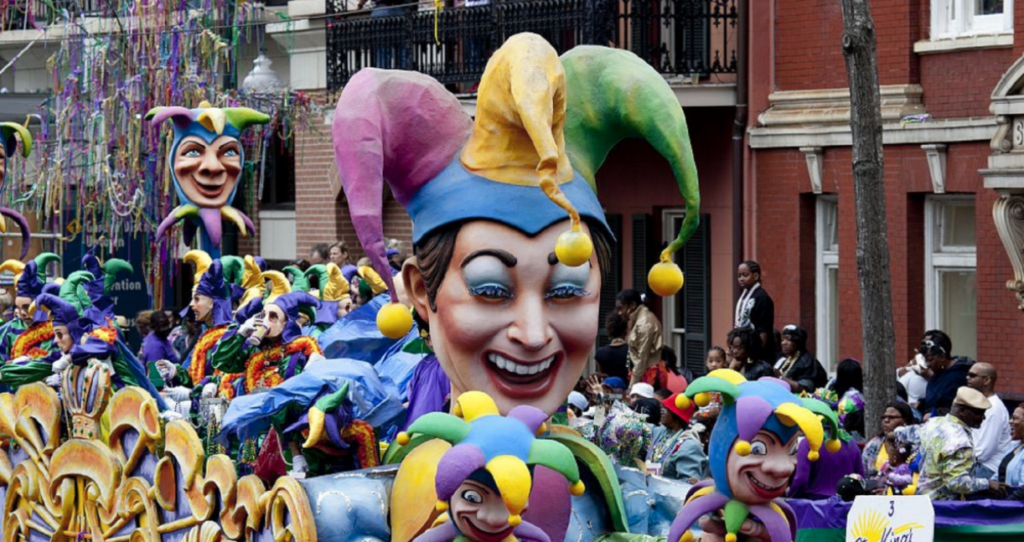Fat Tuesday Guide
- Introduction
- Mardi Gras History
- Fat Tuesday Around the World
- How to Celebrate Fat Tuesday
- Fat Tuesday FAQs
Fat Tuesday is better known by its French translation, Mardi Gras. It takes place on the final day before Ash Wednesday, which marks the beginning of the liturgical season of Lent.
Also known as Shrove Tuesday or Pancake Day, Fat Tuesday has a rich history in both the U.S. and across the world and represents a day when Catholics and other Christians come together in celebration before the more subdued observance of Lent.
Fat Tuesday/Mardi Gras History in New Orleans
Fat Tuesday in America predates the birth of the U.S. Some form of Fat Tuesday celebration has been taking place in New Orleans since 1699.
Back then, the celebrations stretched from the Epiphany (or 3 Kings Day), which is sometimes referred to as the 12th Night (a reference to the 12 Days of Christmas).
“The end of Carnival and the arrival of Lent meant only the end of masked balls; public balls continued,” he wrote. “What distinguished dances between Twelfth Night and Ash Wednesday was that they were bals masque, or costume balls.”
Notable Fat Tuesday celebrations throughout history include the festivities in 1804, the first with Louisiana as a part of America. The first modern Mardi Gras took place in 1857. The 1946 celebration marked the first Mardi Gras in four years after being canceled in 1942 due to World War II.
Few people realize that the colors of beads tossed around at Mardi Gras have religious significance. The official colors are purple for justice, green for faith, and gold for power. Shirley Henderson, former communications director for the Diocese of Biloxi (adjacent to New Orleans, said that, despite seeming secular, Mardi Gras is actually “a kind of evangelizing.”
While Mardi Gras is now synonymous with New Orleans, the broader idea of Fat Tuesday is something observed in many places across the world.
Fat Tuesday’s Catholic Roots Around the World
Brazil has Carnival; Italy, Martedi Grasso. It’s also known as Pancake Day in some parts of the world.
Fat Tuesday is also called Shrove Tuesday. According to the Diocese of Little Rock, Shrove Tuesday comes from the term “to shrive,” meaning “to confess,” or to hear confessions–a way to prepare our hearts for the beginning of Lent dating back to the Middle Ages.
The name Pancake Day comes from the tradition of people returning home after the sacrament of confession and enjoying a big feast of pancakes.
It’s not coincidental that the last day before Lent, a period marked by solemness and penitence, has been one that different countries have embraced as a day of merriment.
“It was natural to develop a festival, a ‘last fling,’ before the prayerful fasting and abstinence of Lent,” according to Creighton Online Ministries.
There’s also an element of using up some of the tempting items of food and drink in the house before Lent begins–as well as using them before they might spoil over the 40 days of Lent.
While Fat Tuesday should not be a day of raucous, unbridled excess and pleasure, it’s a day that can be observed with plenty of traditional celebrations held dear by Catholics and other Christians for centuries.
How to Celebrate Fat Tuesday
Since Fat Tuesday is the last day in ordinary time before the season shifts to Lent, the most important way to observe Fat Tuesday is by making sure you’re prepared for Lent. It’s a day when people often decide what to give up for Lent and brush up on Lent fasting rules or where to get ashes.
Celebrating the day itself can often be a communal experience.
Polish communities sometimes call Fat Tuesday Paczki Day, a reference to the cream or
jelly-filled doughnut traditionally eaten this day. Many churches will celebrate “Paczki Day” by sharing the pastries after Mass.
In cities with large Polish populations, like Chicago, paczki can seemingly unite an entire city on Fat Tuesday.
In Texas and parts of the South, king cake is a popular Fat Tuesday indulgence. With Mexican roots tying the cake to “rosca de reyes,” a cake traditionally served on 3 Kings Day, the king cake is shaped like a ring to represent God’s infinite love and contains a plastic figurine of Jesus.
Whoever gets the piece with the figure of Jesus receives good luck and must host the next gathering with friends and family.
“Pancake Supper” is another popular tradition that some Catholic parishes (as well as Episcopal churches) will observe on Shrove Tuesday.
Frequently Asked Questions about Fat Tuesday
In 2025, Fat Tuesday takes place on March 4. It always falls on the Tuesday before Ash Wednesday.
There are fasting guidelines on Ash Wednesday and throughout Lent, but Fat Tuesday generally does not have restrictions on what to eat.
Pancakes have a long history as a Fat/Shrove Tuesday meal. They are a rich food often made with eggs, butter, and some sugar, ingredients traditionally used less often in Lent.
Fat Tuesday celebrations take place as a way for people to come together and share a celebratory day before the more somber, penitential period of Lent.
In some cultures, Fat Thursday is the final Thursday before the start of Lent on Ash Wednesday. It takes place several days earlier than Fat Tuesday but contains many of the same celebrations.
